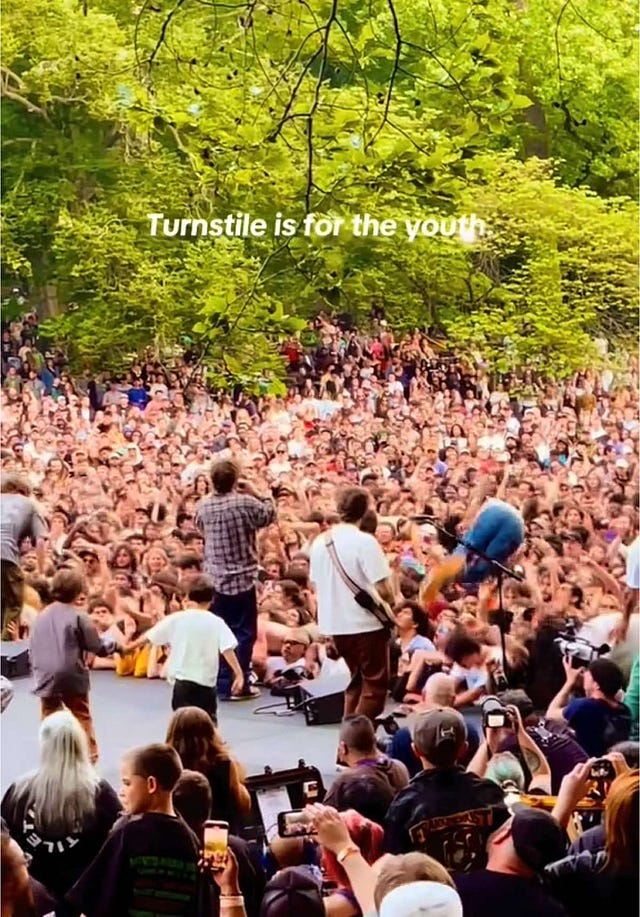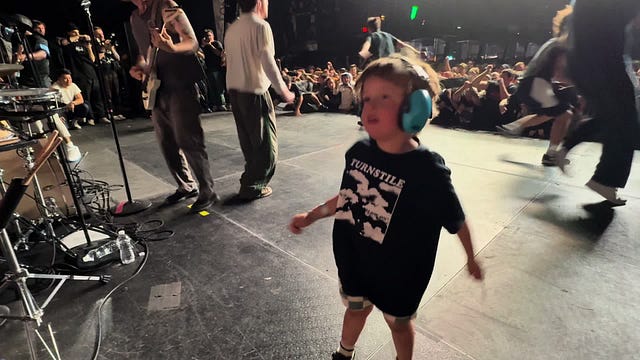The new Turnstile record is quickly becoming my summer soundtrack, and arguably the summer soundtrack. After their 2021 album GLOW ON earned them mainstream recognition and a dream opening slot on the blink-182 tour, they ignored the music business playbook and waited four years to release new music, but it was worth the wait. People are calling them the biggest hardcore band in the world, and hardcore is calling them sellouts. NEVER ENOUGH (2025) is another breakthrough record, reaching an even wider audience, but they’ve been making music for more than a decade. They’re a band full of wonderful, thoughtful contradictions.
In a profile for the New York Times, frontman Brendan Yates says, “Hardcore music in general can be about grief, sadness, anger, happiness, joy, triumph. It can be all of those things, but I feel like it always presents as something that makes you feel good […] The heaviness and the aggression are a healthy way to process some of those feelings that humans naturally have.” This attitude towards hardcore as a genre explains why so many people find Turnstile mosh pits to be wholesome spaces, the right kind of rowdy:
I’ve been in good moshes, and I’ve been in bad moshes. You can feel when a mosh is good, in my experience, right when the crowd starts to jump; it’s an energy thing. Moshes have unspoken rules, about where your elbows go and what to do when someone falls down. I was recently explaining to a friend who has never been in a mosh pit what it feels like to careen into other people at high speeds with the kind of aggression that is joyful. I don’t really think he got it.
But these kids get it! At Turnstile’s free benefit show in their hometown of Baltimore, which probably drew a crowd of around ten thousand, there were kids having a blast crowd surfing. Imagine being that small, how good crowd surfing would feel. Look how happy this guy is:
Turnstile is a really interesting case of a band that found a wider listener base simply by experimenting with their sound while staying true to their roots. I would say that this trajectory is the dream for most if not all bands: to have the freedom to explore without the fear of slipping into obscurity as fans become dissatisfied, wanting more of the same. Turnstile has embraced a certain amount of attrition that they see as inherent to growth and trust that their new fans still subscribe to the ethos of hardcore, even if the sound is less and less hardcore by the book. Baltimore, the home of the genre, helps them stay grounded in this space; all the members except for Mills still live there (she’s from the UK).
Hardcore is a sound especially built on an idea, rather than an arbitrary sonic classification, but I think a lot of bands, regardless of genre, could take a page out of Turnstile’s book. Trusting your fans to understand your vision is a special thing, a risk with high reward. Turnstile gets bigger and bigger not because their music is more palatable to the mainstream, but because they have fostered an obvious positive relationship with the people that loved them and continue to do so.
The experimentation the band gets to do is facilitated by this groundwork, which is an equally important but often overlooked aspect of rockstardom as making hard hitting music. Having good fans creates a feedback loop that aids artistry; the shows are more fun, more electric, and people hear about that experience and want to be a part of it. Whether or not your music is technically hardcore is beside the point—it bangs. Welcome to Turnstile summer.









That live video ❤️